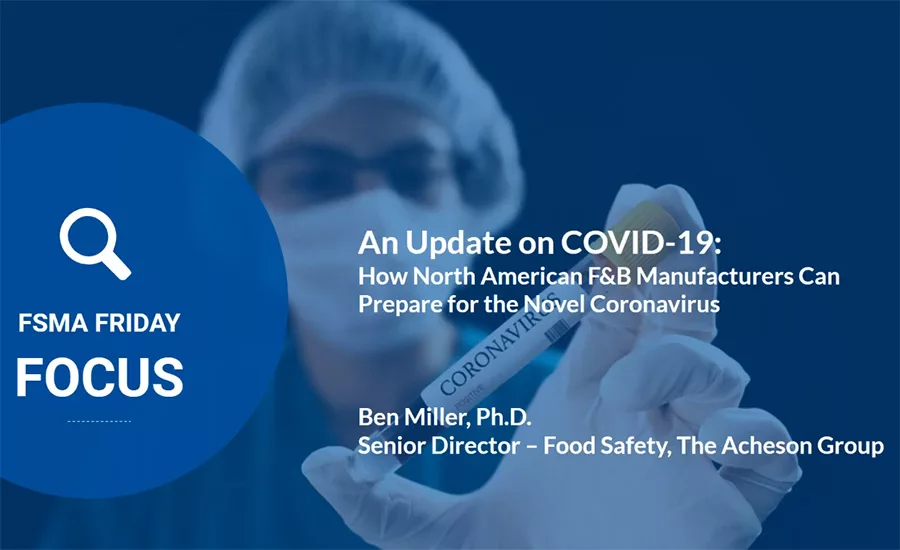Coronavirus
COVID-19: Can it survive the supply chain?
While COVID-19 is not so easily transmittable through the supply chain, nevertheless, it can take out key players when their staff gets sick

In a recent “FSMA Friday” webinar, hosted by Safety Chain and The Acheson Group, Dr. Ben Miller, senior director-food safety for the Acheson Group brought hundreds of listeners up to speed on the COVID-19 (coronavirus) outbreak in the U.S, which at that time had only affected fewer than a couple dozen people. The spread is currently over 16,000 cases in the U.S. with New York State alone reporting more than 7,000 cases and 38 deaths. The next FSMA Friday update is scheduled for 27 March 2019 at 12:00 noon (Eastern Time in the U.S.).
While the infection continues to spread exponentially, Miller suggested that food companies should perform due diligence with suppliers, even though the risk of virus transmission in the supply chain is low. The larger risk is staffs being cut short due to workers calling in sick with the virus, causing supply chain interruptions. Miller advised that processors will need to identify alternate suppliers to have consistent inputs; however, other processors will be doing the same, which can make locating these sources more difficult.
While workers should follow hand washing rules specified by CDC, adequately cleaning surfaces is a must. Miller noted that COVID-19 on surfaces is resistant to usual cleaning agents, but bleach and hydrogen peroxide are effective. “Clean and sanitize commonly used or handled surfaces (doorknobs, countertops, workspaces, etc.),” says Miller. Use the following agents on a surface for a period of one minute to ensure deactivation of the virus: 62-71% ethanol, 0.5% hydrogen peroxide or 0.1% sodium hypochlorite (1:50 standard bleach solution).
Just how long can COVID-19 survive on surfaces? It depends on the surface material. In research presented on the New England Journal of Medicine, researchers found COVID-19 was more stable or viable on plastic and stainless steel (meaning it lives longer) than on copper and cardboard, and viable virus was detected up to 72 hours after application to these surfaces, although the virus titer was greatly reduced (from 103.7 to 100.6 TCID50 per milliliter of medium after 72 hours on plastic and from 103.7 to 100.6 TCID50 per milliliter after 48 hours on stainless steel…On copper, no viable COVID-19 was measured after 4 hours. On cardboard, no viable COVID-19 was measured after 24 hours.
Therefore, long-term viability of the virus on packaging in the supply chain is, according to Miller, a low risk as he suggested that even if the virus were viable for as long as nine days, in most container shipments from Asia or otherwise would most likely exceed this period or the shorter periods that the researchers reported above.
Can the virus survive in food or water, hot or cold? According to The Acheson Group’s FAQs on its continuously updated website geared to the food and beverage industry, current knowledge suggests there is no evidence to suggest the spread of coronaviruses through food or water. Freezing is a common method of preserving viruses in a lab, and therefore, it’s to be expected that viable SARS virus types can survive more than 21 days at 39°F. There is no specific heating data on COVID-19, but data on SARS (2003) shows that it can be inactivated when held at a temperature of 133°F between 15 and 30 minutes.
A few resources:
Coronavirus (COVID-19) Webpage on the Centers for Disease Control
Looking for quick answers on food safety topics?
Try Ask FSM, our new smart AI search tool.
Ask FSM →
“COVID-19: towards controlling of a pandemic,” The Lancet, Juliet Bedford, Delia Enria, Johan Giesecke, David L Heymann, Chikwe Ihekweazu, Gary Kobinger, et al.; Published:March 17, 2020DOI:https://doi.org/10.1016/S0140-6736(20)30673-5; PlumX Metrics
The New England Journal of Medicine, Recent information on COVID-19
For more information on COVID-19, visit the Acheson Group’s website at https://www.achesongroup.com/covid-19.
“SARS-CoV-2 (Coronavirus) and COVID-19 Disease Quick Reference And Response Guide,” Diversey website









